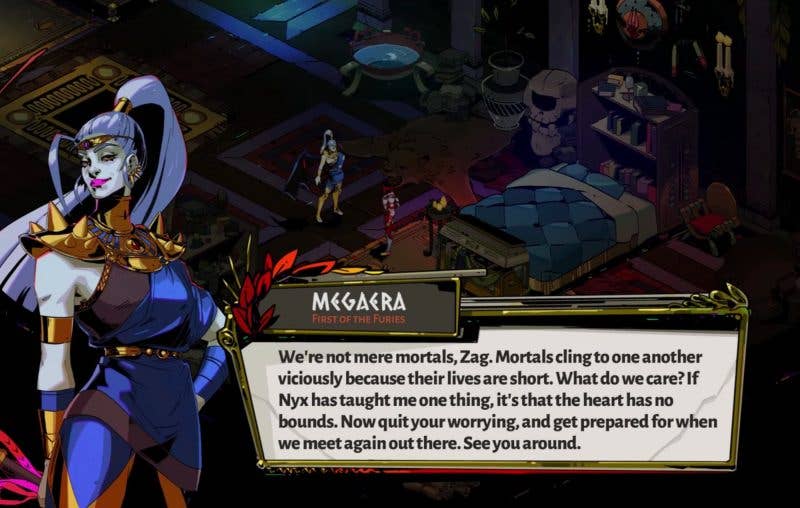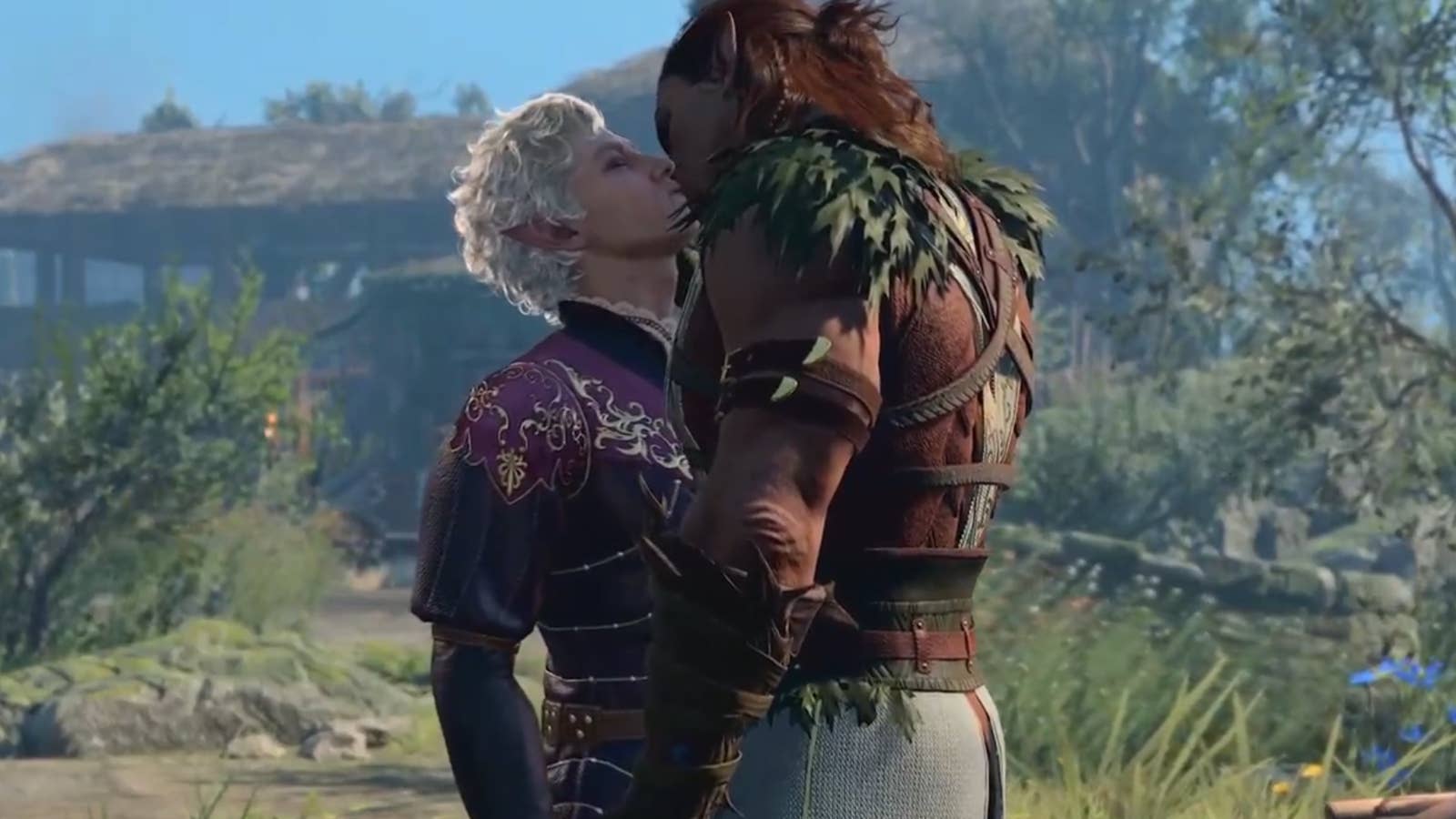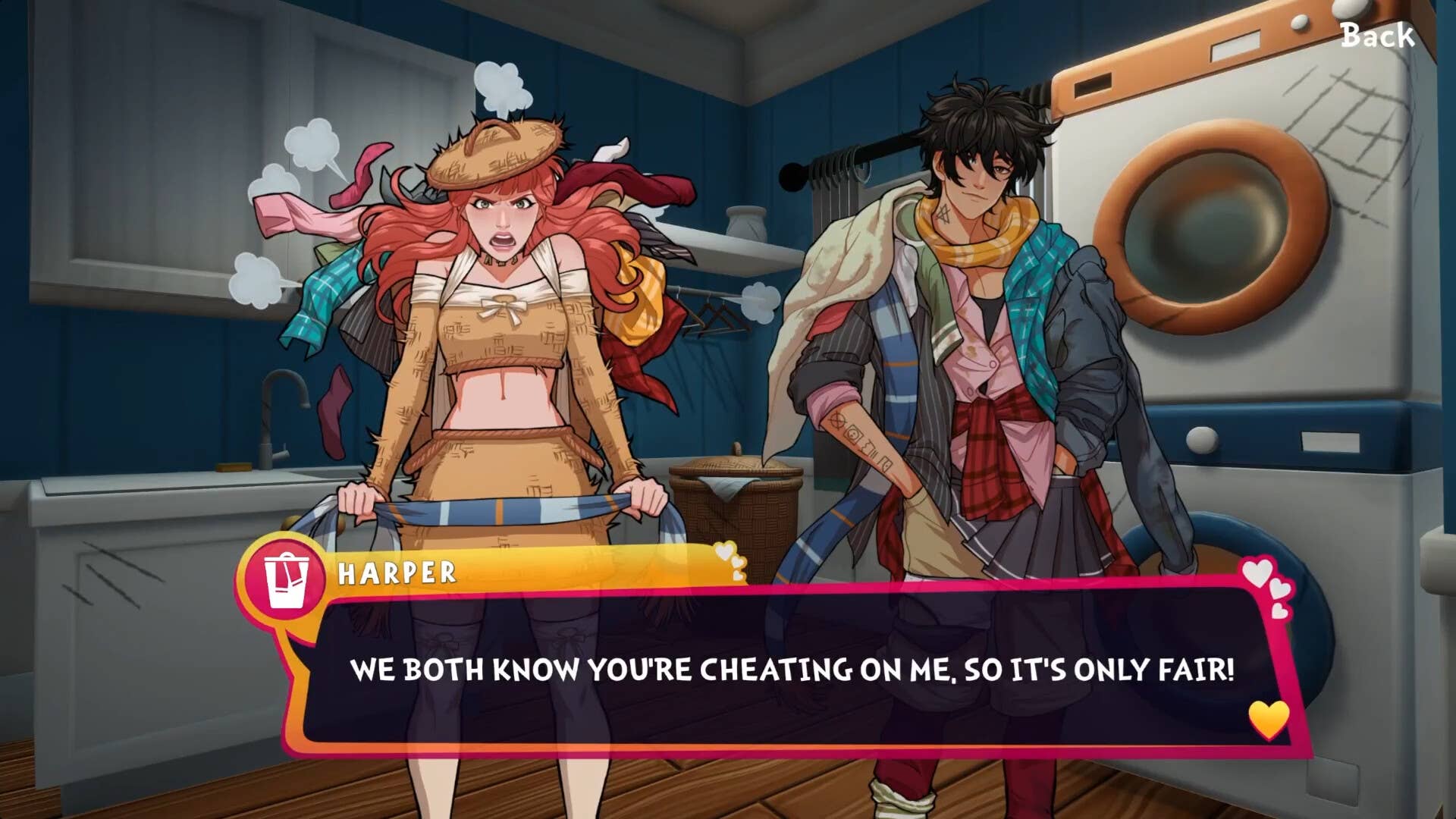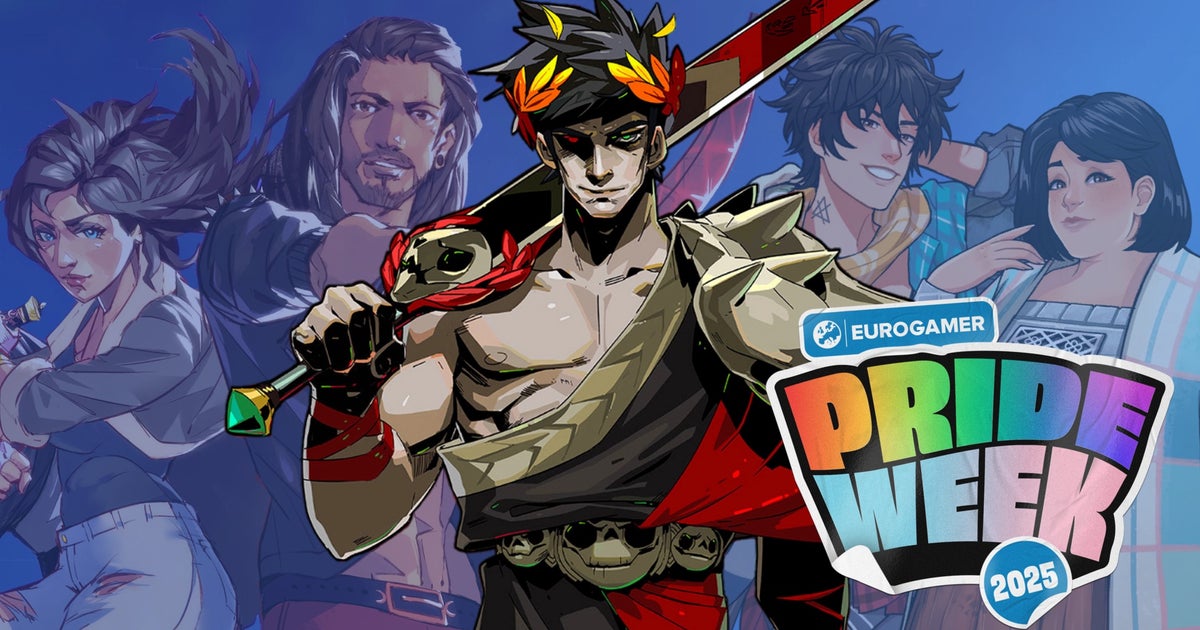Hello! Eurogamer’s week of features celebrating the intersection of queer culture and gaming continues today as Dom Peppiatt explores polyamory in games. And if you want catch up on previous years’ festivities – as well everything you might have missed so far this week – why not visit our Pride Week hub?
It’s hard work being a polyamorous farmer. As well as building fences, keeping the birds from pecking at my seeds, tending to my crops, and picking up goods from the local shopkeep, I’ve got a couple of boyfriends on the go. Farming isn’t just hoeing around, after all (sorry). Just like in real life, I am steadily progressing my relationships in Stardew Valley by working my way up to getting ten hearts with the mountain-loving, basement-dwelling Sebastian and the energetic, spiky-haired Sam.
It’s all going well enough; I’ve learned that Sam likes pizza dates and Sebastian is a sucker for sashimi. That’s one of my favourite things about being poly, you know – both in-game and outside of it: you get to indulge different parts of your personality and taste with different people. Why should I have to live with just pizza or sashimi? Why can’t I have both?
Sometimes, I even head over to Sam’s house and see him and Sebastian jamming together, Sam on the guitar whilst Sebastian plays something no-doubt minor keyed and depressing on the piano. My metamours hang out when I’m not there; that’s so nice. That’s so encouraging! There’s clearly no jealousy or anything here. This kitchen table approach to polyamory (ergo: everyone involved in the relationship is integrated and collaboration is prioritised) is working!
But then it all falls apart. I got married to Sebastian – which wasn’t an issue, even when playing as a male character, nice – and continue my relationship with Sam. But now we’re all ring-fingered, going over to Sam’s and giving him a pizza makes Seb jealous. What? Why? What has changed now that we’re betrothed? Didn’t we just express our love in the most dramatic and legally-binding of ways? What’s changed now that we’re married? I am left confused, a bit irritated, and I end up abandoning my virtual farm – and my multiple Stardew Valley relationships – as a result.
By video game standards, this is good polyamorous representation. And it still manages to fail to provide a good option for this lifestyle. The vast, vast majority of games focus on either one ‘main relationship’ for the player to be engaged in, or let you indulge in a series of casual hook-ups before settling for ‘the one’. I find this restrictive. I find it, honestly, unrealistic.
I have been poly now for nearly ten years. Polyamory is the practice of engaging in romantic relationships with more than one partner at the same time, with the informed consent of all partners involved. Sometimes known as ethical non-monogamy, the practice generally puts an emphasis on communication, consent, and honesty between all involved parties. The beauty of relationships is that they can come and go, and you can enjoy them for what they are whilst they last and know when to let go when they no longer serve you. With non-monogamy (and lots of good communication, self-knowledge, and emotional maturity), you can hold multiple relationships like this at the same time – maybe even see how they support one another and work harmoniously to improve each other.
There are a dearth of video games that even observe polyamory as a viable option, let alone give you the options and tools to pursue it. The most notable example I can summon is Hades, where you play as Zagreus, the sarcastic, opinionated, yet oddly empathetic Greek demi-God. He is the posterboy of bisexuality, as far as I am concerned: at once suave, quick-witted and wicked-tongued. Sexy without being smutty. Cocksure but also kinda shy. He’s a wonderful agent for us to explore the Greek underworld as in Supergiant‘s stellar roguelike.
He’s also polyamrous. Or, he has the option to be. Play through enough of this Greek tale of tragedy, and you’ll eventually get to engage with romance options with Dusa, Megaera and Thanatos. Whilst I read Dusa as a more ‘queerplatonic’ option, Megaera and Thanatos are clear about their intents with Zagreus, and it gives the game a solid foundation in which to explore both non-monogamy and kink – in a refreshingly honest way.
“When it came time for Zagreus to have relationships with Megara and Thanatos – and how they interact at this point – it made sense to [go the polyamorous route], especially in this setting,” Supergiant Games’ creative director Greg Kasavin once told me in an interview, back in 2021. “It didn’t make sense to do it any other way, I would say. They’re Gods! Their value system is different, and they don’t face the kinds of challenges around having to be the person that they want to be – and be with the people they want to be with – in that world.

“That’s how we cut through some of the stereotypes. […] Zagreus potentially being polyamarous, as a particular detail, that wasn’t necessarily there at the start of development, and it’s something that evolved as we developed the game,” explains Kasavin. “And [his sexuality] happens to be authentic to Ancient Greece, as well – one of the most compelling questions I found when writing Hades was asking myself ‘in what ways has society changed in three thousand years? In what ways has it not changed? In what ways has it potentially even moved backwards?’”
Good question. Megaera – known as the Fury that punishes jealousy, notably – has a great line for Zagreus when he confesses his concerns about falling in love with both her and Than at the same time. “We’re not mere mortals, Zagreus,” she says. “Mortals cling to one another viciously because their lives are short. What do we care? If Nyx has taught me one thing, it’s that the heart has no bounds. Now quit your worrying, and get prepared for when we meet again out there. See you around.”
It’s enough to make you blush. But taking that logic and expanding it to our ‘mere’ mortal brains isn’t so hard; for the right people, opening your heart to more than one person at once feels natural. Unavoidable, even. And I think Hades might be one of the only games that gets that.
But that’s not to say it’s alone. I Was a Teenage Exocolonist shows a really nice relationship between gardener Sym and the anxious Dys, which you can join later on if you don’t romance Dys in the earlier portion of the game. Via different endings, the game actually interrogates the ‘V-shaped’ polycule – where two people love one person – and a more traditional ‘triad’ structure where all three individuals are romantically linked (though Dys and Sym will have a different relationship, since they were together longer). It’s a very nuanced take on polyamory, and really feels like a lived experience to me, especially as a human that was the ‘hinge’ of a V-shaped polycule for over four years. It’s representation I haven’t seen, really, in wider media. Let alone games.
Halsin in Baldur’s Gate 3 deserves a mention. If you’re already involved in a relationship when he comes at you with his feelings, the consent-driven, pressure-free way he conducts himself should be a lesson to all. Halsin puts your partner’s feelings first, sounds you out on your feelings about being in multiple relationships, and is a class act all the way. A must-play dynamic for any of you with a thing for bears (sorry). And that would appear to be a lot of you!

Elsewhere, you have more traditional RPGs that sort-of get the balance right. Some games, like Fallout 4, let you romance multiple NPCs and there is no jealousy or greying-out of options just because you have fallen in love with someone else. Instead, other partners just kinda… stand there, immobile, unresponsive, when you’re saying outrageous things to another human. It’s… fine? It’s not great representation, but at least you aren’t actively punished for being an unrepentant flirt. Assassin’s Creed Odyssey was the same; you can romance everyone, but they are ‘player-sexual’ and not necessarily queer – it was just a catch all to make sure both player options (Kassandra and Alexios) could fuck their way across Greece without pause.
In 2024, The Sims 4 launched the Lovestruck pack that separated emotional and physical exclusivity in the game’s mechanics. “Free for all players is the new Romantic Boundaries system that will allow you to customise your Sim’s experience with boundaries and jealousy,” reads a description. “You can now define how your Sims approach romantic relationships in terms of physical and emotional romantic exclusivity. This allows for Sims to date multiple Sims without impact to other relationships.” This is an update that players have been demanding for, hm, I’m going to say decades at this point. There have been Sims mods for non-hierarchical relationships since The Sims 2, but seeing Maxis finally legitimise the player fantasy with official tools was a win for the ever-growing ethical non-monogamous community.
It’s notable that many of these titles – The Sims 4, Baldur’s Gate 3 – also featured prominently in Keza’s bi history of gaming, and remain a high watermark for authentic queer representation in many different aspects, but that’s not to say that other games aren’t picking up the slack, too, with specific, well-written poly options. For a start, there’s Boyfriend Dungeon, where you can be in a polycule with all your weapons at once with no repercussions (what a sentence).

Date Everything!, as you’d expect from a game with that name, has specific paths for you if you want to engage in explicitly poly relationships. Celia and Florence, for example, can be dated separately or as part of a ‘triad’. My favourtie thing about Date Everything’s take on the situation is that you will need to act as a facilitator of sorts in order to engage in polyamory, unpicking a pyramid scheme for Celia and Florence, mending bad blood between Drysdale and Washford, or finding common middle ground between Harper and Dirk. This feels like a reflection of real-world poly issues; it’s nice when your partners get along, but it’s also a very common reality that they simply will not. It’s nice to see a game show an understanding of that, and frame it as a visual novel-style puzzle.
I should shout out Hades 2, too, in which new protagonist Melinoe is also polyamorous, and in a more intentional and nuanced way that Zagreus ever was (but I’m going to reserve judgement on that one until the game is actually, properly out).
Given the lack of poly representation across popular media as a whole, I am actually pretty surprised with how well games handles it; it feels like a lot of games are actually better poised to observe and explore non-traditional relationship structures than many TV shows or movies. Perhaps it’s because there’s a higher level of agency in games, and that player choice naturally lends itself to divining the right relationship – or relationships – as a mechanic in an interactive media comprised almost entirely of, you guessed it, overlapping mechanics.
Or maybe it’s because there is a much higher percentage of queer and non-monogamous people that work in newer industries like gaming and tech. Who knows. Either way, it’s really reassuring to me that as our industry continue to mature, polyamory is becoming a viable option in games, and that more developers are finding ways to utilise the unique challenges and experiences the lifestyle brings to make more interesting titles along with way.
Finally, I will leave you with something Supergian’t Greg Kasavin said to me as he explained why Zagreus has become such an icon for both queer and non-monogamous representation. “[Despite his relationships], there’s still plenty of conflict in the game, including interpersonal conflict, between Hades and Zagreus,” he said. “But it’s never conflict based on who people love; that’s something of no concern to the people in this world. It’s just accepted.”
Here’s hoping one day that won’t just be a fantasy tied to a video game set in ancient Greece, ey?
